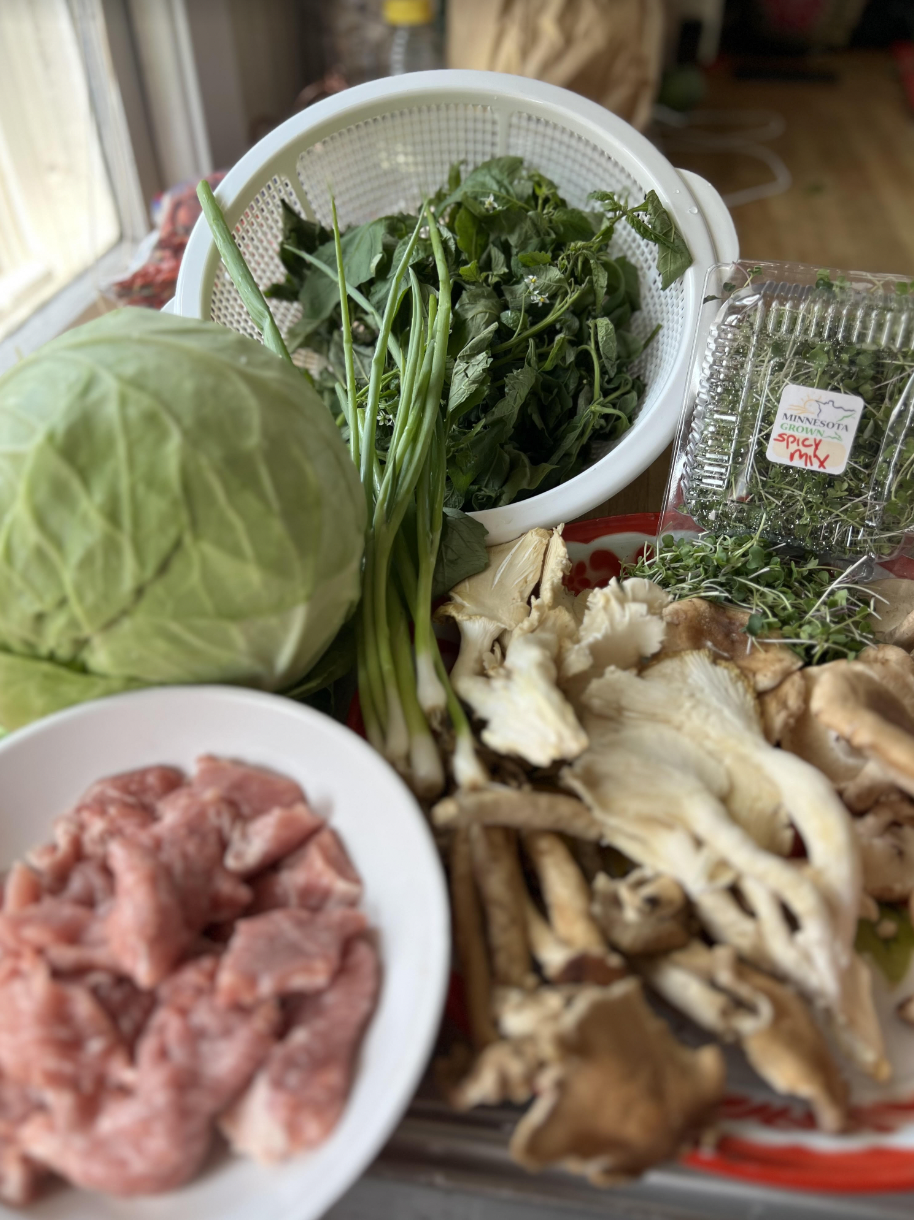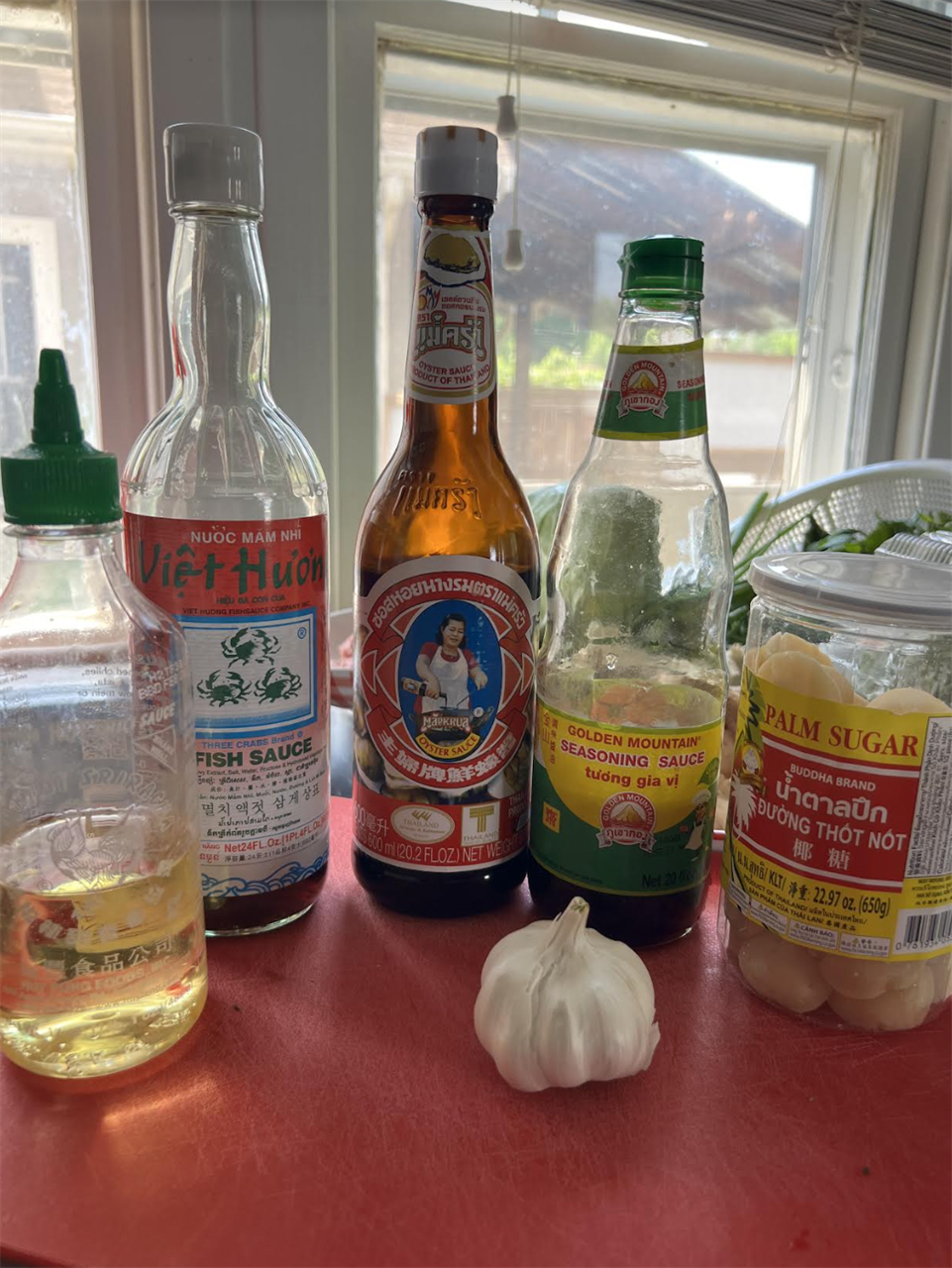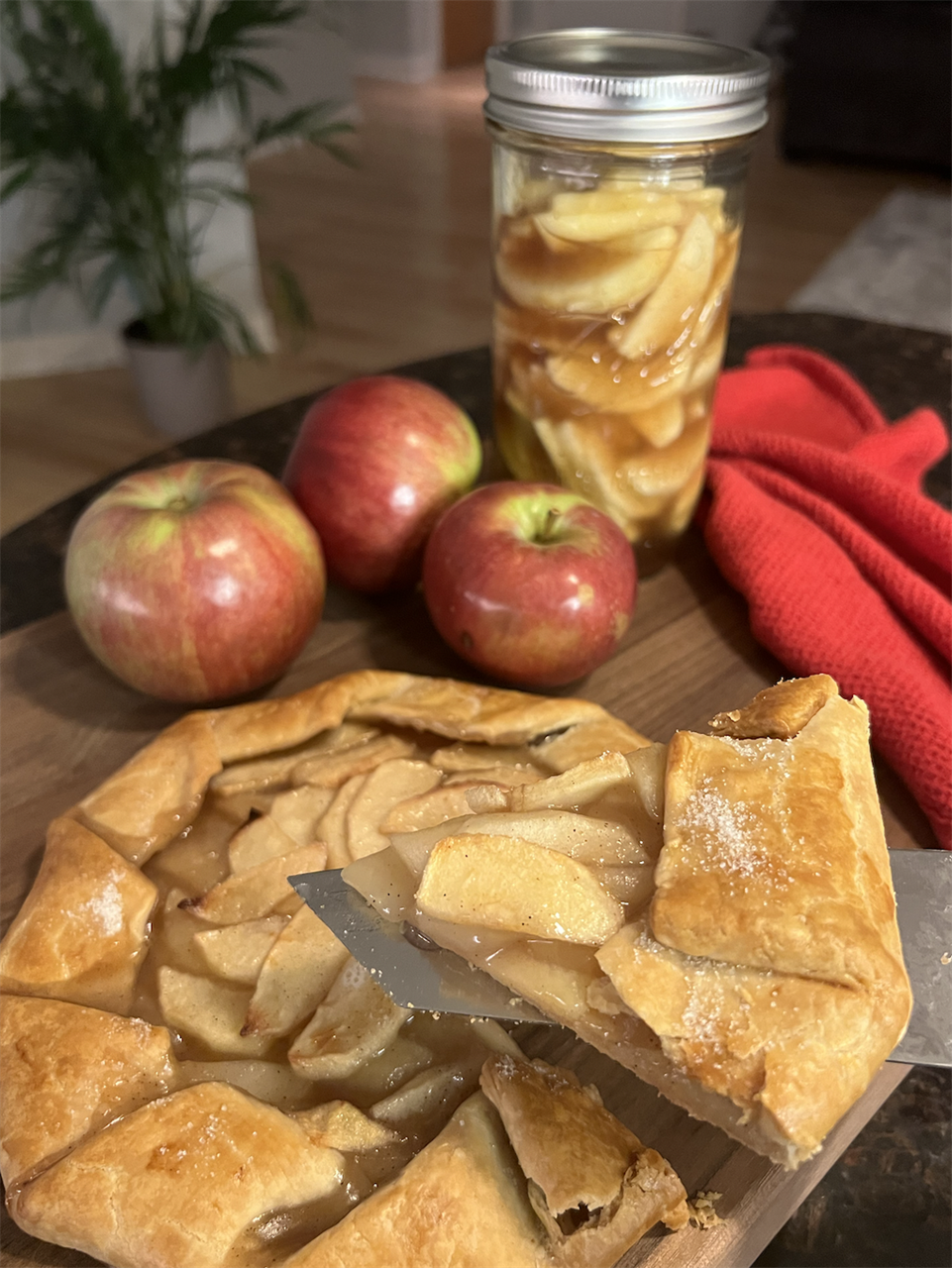|
DECEMBER
NOVEMBER
OCTOBER Fox 9 Good Day - Award Winning Chicken Tortilla Soup (Click here for recipe) Minnesota Live - Beef Noodle Soup "Kuy Teav" (Click here for recipe) Twin Cities Live - Cambodian Chicken Curry (Squash Party!) (Click here for recipe) SEPTEMBER Fox 9 Good Day - Apple Galette with Farmers' Market Apples (Click here for recipe)AUGUST
JULY Beef Stix at the Market (recipe) JUNE |
Homemade Apple Galette with Farmers' Market Apples Blog - September 2023 - By: Sina Pleggenkuhle
Fall is a crucial season for apple farmers as it marks the peak of their harvest. Varieties like the Honeycrisp, developed in Minnesota, are celebrated for their juicy, sweet-tart taste and iconic crunch. The state's apple growers have honed their expertise over generations, producing apples that not only withstand the cold but also offer a taste of the region's resilience and commitment to quality. These Minnesota-grown apples truly embody the spirit of their hardworking farmers and the northern climate they call home. Buying apple seconds in bulk at the farmers' market is a savvy choice for those looking to make the most of fall's apple bounty. These slightly imperfect apples are often just as delicious but come at a more budget-friendly price, making it perfect for creating homemade apple pie canning filling. With this versatile filling on hand, you're ready to whip up a variety of delightful recipes throughout the year. Beyond classic apple pies, you can craft apple turnovers, apple crumbles, apple tarts, and of course, the rustic charm of an apple galette. The options are endless, allowing you to enjoy the warmth and comfort of apple desserts no matter the season, all while supporting local farmers and reducing food waste. It's a win-win for both your taste buds and your community. Farmers often diversify their offerings with value-added products known as cottage foods, which can range from jams and jellies to baked goods and preserves, showcasing their culinary talents and creativity. If you're interested in becoming a cottage food producer and transforming your farm-fresh ingredients into delectable goods, you can explore this exciting opportunity further by registering for the MFMA (Minnesota Farmers' Market Association) Cottage Food Academy. This resource provides valuable insights, training, and guidance on cottage food production, helping you navigate regulations, safety requirements, and marketing strategies, ultimately empowering you to share your farm's delicious creations with a wider audience while supporting local agriculture. Link to Cottage Food Academy: https://mfma.org/Cottage_Foods_Academy Link to MN Cottage Food Producers Association, Tested Recipe Resources: https://www.mncfpa.org/gallery/ Link to Ball's Apple Pie Filling Canning Recipe: https://www.ballmasonjars.com/blog?cid=apple-pie-filling-recipe For the Galette Dough: 1 1/4 cups all-purpose flour 1/4 teaspoon salt 1 tablespoon granulated sugar 1/2 cup unsalted butter, cold and cut into small pieces 3-4 tablespoons ice water For Assembly: 1 egg (for egg wash) 1 tablespoon milk or cream 1 tablespoon granulated sugar (for sprinkling) Instructions: 1. Make the Galette Dough: a. In a separate bowl, whisk together the flour, salt, and sugar. b. Add the cold, diced butter to the dry mixture. Use a pastry cutter or your fingers to work the butter into the flour until it resembles coarse crumbs. c. Slowly add ice water, one tablespoon at a time, and mix until the dough comes together. You may not need all the water; stop when the dough holds together without being too wet. d. Shape the dough into a disc, wrap it in plastic wrap, and refrigerate for at least 30 minutes. 2. Preheat the Oven: Preheat your oven to 375°F (190°C). 4. Roll Out the Dough: a. On a lightly floured surface, roll out the chilled dough into a circle about 12 inches in diameter. b. Transfer the rolled-out dough to a parchment paper-lined baking sheet. 3. Assemble the Galette: a. Arrange the prepared apple pie filling in the center of the dough, leaving about a 2-inch border around the edges. b. Fold the edges of the dough over the apples, pleating as you go to create a rustic border. c. In a small bowl, beat the egg with the milk or cream to make an egg wash. Brush the edges of the galette with the egg wash. d. Sprinkle the edges with granulated sugar for a beautiful, caramelized finish. 4. Bake the Galette: Place the baking sheet in the preheated oven and bake for 40-45 minutes, or until the crust is golden brown, and the apple filling is bubbling. 5. Cool and Serve: Allow the galette to cool slightly before serving. It's delicious on its own or served with a scoop of vanilla ice cream or a dollop of whipped cream. Enjoy your homemade apple galette made with fresh farmers' market apples! |
Farmers' Market Eggroll Recipe Blog - August, 2023 - By: Sina Pleggenkuhle Now is the perfect time to indulge in the vibrant flavors of summer by creating delicious eggrolls using fresh ingredients sourced from the farmers market. With crisp cabbage, juicy carrots, aromatic onions, and farm-fresh eggs, these Cambodian eggrolls are a delightful fusion of local produce and Asian culinary delights. By visiting the farmers market, you not only treat yourself to the finest seasonal vegetables but also support local farmers, fostering a sense of community and sustainability. Embrace the spirit of adventure in your kitchen and try this new recipe, savoring the medley of tastes and textures that will transport you to the heart of Southeast Asia. So grab your shopping bag, head to the farmers market, and embark on a culinary journey that celebrates the bounty of summer while uplifting the hardworking farmers in your neighborhood.Farmers' Market Eggrolls: Ingredients:
Instructions:
Enjoy your delicious eggrolls made with fresh farmer's market finds and Asian grocery store ingredients! |
MFMA and Land Stewardship Project were happy to host Senators Aric Putnam and Heather Gustafson, and other members of the MN Senate Ag Committee at Simple Harvest Farm Organics, Nerstrand, on July 20. MDA Assistant Commissioner Patrice Bailey attended, as did several market managers, food farmers, and folks involved with food policy in MN. Chair Putnam gave MFMA’s and LSP’s bill asking for $10,000 grants to every farmers’ market in MN and the Tribal Nations a hearing in committee during the 2023 session. Although that bill, authored by Senator Mary Kunesh, failed to get funded, the Legislature did fund $200,000 over two years to help farmers’ markets with the costs of SNAP EBT. A tour of Zeman’s Simple Harvest Farm, a MN Ag Water Quality certified farm that has all certified organic inputs and is 100% grass-based with trees in all paddocks for shade for the livestock, included discussions on:
MN’s Local Foodshed is Booming - Where Can Funding Come From For the Needed Infrastructure? Bucking state and national trends of aging and decreasing number of commodity farmers, MN’s small scale and emerging farmers population continues to show marked growth, especially in growing food crops and livestock. The Statewide Cooperative Partnership 2022 data shows that farmers in this category average over 60% more in market value sales per acre than 'all farmers,' in the 2017 U.S. Ag Census. Data confirms the growth and potential of MN’s local foodshed; what’s needed next is funding to support the ‘local foodshed infrastructure,’ also called the ‘community food web.’ Once this investment happens in community commercial kitchens, community food hubs (including farmers’ market food hubs), community food storage warehouses, community food grade transportation, then growth in MN’s ability to grow food increases exponentially, and in doing so builds resilience across greater MN as well as the burgeoning urban ag farms. Senator Gustafson’s bill to provide free meals to school children was passed in 2023. Once the local foodshed infrastructure is built out, it will make it easier for those meals to come directly from MN food farmers, revolving that money in MN. As COVID illuminated, having multiple sales channels for food farmers is critical: farmers’ markets, farm-to-school, farm-to-institution, etc. Senator Putnam said it was his intent for the Senate Ag Committee to visit farms this summer and listen to the stories; the group has 40 farm tours scheduled already. He encouraged our group to research and build relationships with other Legislative committees and state agencies, because our work includes food access, food security, economic development, workforce development, education, etc. Lunch was local! Food came from Rotational Roots, Sevens Songs Organic Farm, Simple Harvest Farm Organics - all three either current or former farmers’ market vendors. Attendees
|
Cambodian Beef Sticks w/ farmers' market vegetable pickle
Blog - July, 2023 - By: Sina Pleggenkuhle
Cambodian Beef Sticks
Ingredients:
1 pound beef, thinly sliced into strips
1/4 cup soy sauce
2 tablespoons chicken soup base
2 tablespoons oil (preferably vegetable or peanut oil)
1 teaspoon black pepper
3 cloves garlic, minced
1 small onion, finely chopped
2 tablespoons honey
2 tablespoons maple syrup
Skewers, soaked in water
Instructions:
In a mixing bowl, combine soy sauce, chicken soup base, oil, black pepper, minced garlic, chopped onion, honey, and maple syrup. Mix well to create a marinade.
Add the thinly sliced beef to the marinade, ensuring that each piece is coated. Allow the beef to marinate for at least 1 hour in the refrigerator, but overnight marination is recommended for more flavorful results.
Preheat your grill or broiler to medium-high heat.
Thread the marinated beef slices onto the soaked skewers, making sure to remove excess marinade.
Place the beef skewers on the preheated grill or under the broiler. Cook for about 2-3 minutes on each side or until the beef is cooked to your desired level of doneness. Baste the beef with the leftover marinade during the cooking process.
Once cooked, remove the beef sticks from the grill or broiler and let them rest for a few minutes before serving.
Cambodian Pickled Vegetables
Ingredients:
2 cups cabbage, thinly sliced
1 cup carrots, julienned
1 cup cucumber, julienned
1 tablespoon salt
1 cup white vinegar
1 cup water
1/4 cup sugar
2 cloves garlic, minced
1 small chili pepper, thinly sliced (optional, for heat)
Instructions:
In a large bowl, combine the sliced cabbage, julienned carrots, and julienned cucumber. (Sub cauliflower, ginger, or other vegetables found seasonally available at the farmers’ market.)
Sprinkle salt over the vegetables and toss well to distribute the salt evenly. Let the vegetables sit for about 15-20 minutes to draw out excess moisture.
While the vegetables are resting, prepare the pickling liquid. In a saucepan, combine the white vinegar, water, sugar, minced garlic, and sliced chili pepper (if using). Bring the mixture to a boil, stirring until the sugar has dissolved. Remove from heat and let the pickling liquid cool to room temperature.
After the resting time, rinse the cabbage, carrots, and cucumber under cold water to remove the excess salt. Drain well and pat dry with a clean kitchen towel or paper towels.
Transfer the rinsed and drained vegetables to a clean, sterilized jar or container.
Pour the cooled pickling liquid over the vegetables, making sure they are completely submerged. If needed, use a weight or a small plate to keep the vegetables submerged in the pickling liquid.
Cover the jar or container tightly and refrigerate for at least 24 hours to allow the flavors to develop. For best results, let it pickle for 2 to 3 days.
Once pickled to your liking, the Cambodian Pickled Vegetables are ready to be enjoyed. Serve them as a side dish or condiment with your favorite Cambodian or Asian dishes.
Note: The pickled vegetables can be stored in the refrigerator for up to 2 weeks. The flavors will continue to develop over time.
Spring/Rice Paper rolls using seasonal farmers' market ingredients
Blog - June, 2023 - By: Sina Pleggenkuhle
Spring Rolls, with their delicate and translucent rice paper wrappers, provide the perfect canvas for showcasing the vibrant flavors and textures of seasonal farmers market ingredients.
Seasonal produce adds a burst of flavor and freshness to the rolls, creating a harmonious blend of tastes and textures. Whether you choose to incorporate smoked trout, roast pork, tofu, or a medley of both, spring rolls can be customized to suit any preference or dietary requirement.
The beauty lies in the ability to experiment and adapt the fillings based on what the farmers’ market offers, allowing each bite to be a celebration of the current season's bountiful harvest.
For the Spring Rolls Ingredients:
Rice paper wrappers
1 cup cooked rice noodles
1 cup mixed fresh herbs (such as cilantro, basil, and mint)
1 cup thinly sliced seasonal vegetables (such as microgreens, cucumber, radishes and bell peppers)
1 cup cooked smoked trout, pork belly/roast or tofu, sliced into thin strips
Bean sprouts (optional)
Fresh lime wedges (for serving)
Instructions:
Prepare all the ingredients and arrange them on a clean working surface. Have a shallow dish or bowl filled with warm water ready for dipping the rice paper wrappers.
Dip one rice paper wrapper into the warm water for a few seconds until it becomes pliable. Place the wet wrapper on the working surface.
Layer a small handful of cooked rice noodles on the lower third of the rice paper wrapper.
Add a few slices of cooked shrimp or tofu on top of the noodles, followed by a handful of mixed fresh herbs, thinly sliced seasonal vegetables, and bean sprouts if using.
Roll the bottom of the wrapper over the filling tightly. Fold the sides inward, and continue rolling until you have a tightly sealed spring roll. Repeat with the remaining ingredients.
Serve the spring rolls with the dipping sauce and fresh lime wedges on the side. Enjoy your delicious Cambodian-style spring rolls made with fresh seasonal farmers market ingredients!
For the Peanut Butter Hoisin Sauce Ingredients:
1 tablespoon butter
2 tablespoons creamy or chunky peanut butter
3/4 cup hoisin sauce
1 tablespoon lime juice (Optional)
2-4 tablespoons warm water (as needed for desired consistency)
Instructions:
In a small sauce pot on low heat, combine the creamy peanut butter, hoisin sauce and butter. Stir well to combine the ingredients.
Gradually add warm water, one tablespoon at a time, while stirring continuously. The water helps to thin the sauce and achieve the desired dipping consistency. Add more water if you prefer a thinner sauce or less if you prefer a thicker sauce.
Continue stirring until the ingredients are well incorporated and the sauce is smooth. Taste and adjust the seasoning if needed. You can add more soy sauce for saltiness, lime juice for tanginess, honey or maple syrup for sweetness, or red pepper flakes for spiciness according to your preference.
Transfer the dipping sauce to a serving bowl and garnish with some chopped peanuts, green onion or sesame seeds if desired.
Serve the peanut butter and hoisin dipping sauce alongside your spring rolls.
Unfortunately, many Minnesota farmers are facing their third straight year of drought conditions. Click here to read MFMA's drought story on Morning Ag Clips.
Farmers' Market Inspired
Cambodian Stir-Fry
Blog - June, 2023 - By: Sina Pleggenkuhle
Exploring the farmers' market is like embarking on a culinary treasure hunt, filled with seasonal vegetables and unique finds that awaken the senses and inspire creativity in the kitchen. Every visit is a chance to discover the hidden gems cultivated by dedicated farmers like You Pao Xiong, who introduces us to the world of bitter leaves. These vibrant and intriguing leaves, with their distinct flavor profile, invite us to broaden our culinary horizons and embrace new tastes and textures. And then there are the pioppino mushrooms, a revelation from Tiny Tinks Farms, which captivate with their delicate yet robust nature. Their earthy aroma and tender flesh elevate any dish they grace. Elevate your dishes with a touch of freshness and a hint of spice by garnishing it with Spicy Mix microgreens, sourced from the innovative urban farmer Good Day Farmstead. By incorporating these seasonal vegetables and unique finds into our cooking, we not only indulge in the freshest and most flavorful ingredients, but we also honor the dedication and passion of the farmers who nurture and cultivate these treasures. Let the farmers' market be our playground of inspiration, where we can celebrate the beauty and diversity of nature's bounty and unleash our culinary imagination with every unique find.
Step into your kitchen, armed with the finest ingredients from your farmers' market, and prepare to delight in a stir fry that not only tantalizes your taste buds but also celebrates the abundant offerings of your local food scene.



Pictured Left to Right: Various local vegetables & pork found at the farmers' market, Bitter Leaves from Farmer You Pao Xiong & Cambodian stir-fry sauce ingredients
Farmers' Market Inspired Cambodian Stir Fry by MFMA Communications Director Sina W. P.
Ingredients:
1 pound pork rib meat, thinly sliced
4 cloves garlic, minced
6 oyster mushrooms, sliced
6 shiitake mushrooms, sliced
6 pioppino mushrooms, sliced
2 cups cabbage, thinly sliced
2 cups bitter leaves (such as mustard greens or dandelion greens), chopped
2 green onions, chopped
1 cup spicy mix microgreens
2 tablespoons vegetable oil
2 tablespoons oyster sauce
1 tablespoon fish sauce
1 tablespoon soy sauce
2 tablespoons palm sugar (or brown sugar)
Salt and pepper to taste
Instructions:
In a small bowl, mix together the oyster sauce, fish sauce, soy sauce, and palm sugar until the sugar is dissolved. Set aside.
Heat the vegetable oil in a large pan or wok over medium-high heat.
Add the minced garlic and sauté for about 30 seconds until fragrant.
Add the pork rib meat to the pan and stir-fry for 3-4 minutes until it starts to brown.
Add the sliced mushrooms to the pan and continue stir-frying for another 3-4 minutes until they are tender.
Add the sliced cabbage and bitter leaves to the pan and stir-fry for 2-3 minutes until they begin to wilt.
Pour the prepared sauce over the stir fry and stir well to coat all the ingredients evenly.
Continue stir-frying for another 2-3 minutes until everything is cooked through and well combined. Season with salt and pepper to taste.
Remove the pan from the heat and transfer the stir fry to a serving dish.
Garnish with chopped green onions and a generous handful of spicy mixed microgreens.
Serve the stir fry hot with steamed rice or noodles.

Enjoy your flavorful Cambodian-style stir fry with pork rib meat, mushrooms, cabbage, bitter leaves, and garnished with green onions and spicy mixed microgreens!
Blog - June 15th, 2023 - By: Sina Pleggenkuhle The combination of strawberry and rhubarb is perfect for celebrating the summer season. It's important to support local farmers during challenging times like our drought. By visiting the farmers' markets early, we can ensure we get the fresh strawberries before they sell out and show our support for the farmers who have been affected by the reduced production. Enjoy the delicious Strawberry Rhubarb drink and appreciate the hard work of the farmers in bringing these ingredients to our tables! Here is a fun way to enjoy the magical combination of strawberry & Rhubarb. Be sure to visit our Find A Market Map to explore the over 350 farmers' markets in our state! Strawberry Rhubarb Lemonade Ingredients: 1 cup rhubarb, chopped 1 cup strawberries, hulled and sliced 1 cup freshly squeezed lemon juice 1/2 cup Honey (adjust according to taste) 4 cups cold water Ice cubes Fresh mint leaves for garnish (optional) Preparation Instructions: In a saucepan, combine the rhubarb, strawberries, and honey. Cook over medium heat, stirring occasionally, until the fruits become soft and release their juices, about 10-12 minutes. Remove the saucepan from heat and let the mixture cool slightly. Once cooled, transfer it to a blender or food processor and blend until smooth. Strain the blended mixture through a fine-mesh sieve into a pitcher, pressing down with a spoon to extract all the liquid. Discard the solids. Add the freshly squeezed lemon juice to the pitcher and stir well to combine. Add cold water to the pitcher and stir again. Taste and adjust the sweetness by adding more honey if desired. Chill the lemonade in the refrigerator for at least 1 hour to allow the flavors to meld. When ready to serve, fill glasses with ice cubes and pour the strawberry rhubarb lemonade over the ice. Garnish with fresh local mint leaves if desired. Stir gently and enjoy! Note: You can adjust the sweetness and tartness of the lemonade by adding more sugar or lemon juice according to your preference. Additionally, you can also experiment with adding sparkling water for a fizzy variation of this refreshing drink. Pictured is Communications Director Sina Pleggenkuhle shopping for strawberries & rhubarb on opening day of the Nokomis Farmers Market located in Minneapolis. |








